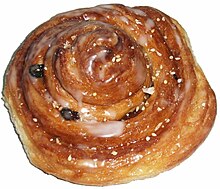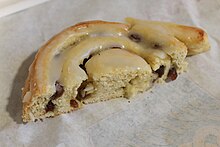Snail (pastry)
Especially in Germany and Austria, snails are a well-known pastry that is wrapped in a snail shape. Snails are made with sweet or savory fillings or sweet or savory toppings. In Salzburg the stuffed snail noodles made from yeast dough are also called pipe noodles .
In some areas the pastry is called snail noodle , or roll cake . The name is due to the similarity of the finished piece of cake with a snail shell . The basic substance is a Danish pastry , yeast or sweet yeast dough. After rolling out, the dough is usually filled with different fillings and rolled up (wrapped), then cut into slices, possibly covered with a topping and baked. After baking, the snails are apricotized and glazed, depending on the product . Screws are rolled up either from one end to the other or from both ends towards the middle, creating a double screw .
Cute snails
Oven baked
Common and typical variants are snails from yeast dough with marzipan - or persipan -Filling and raisins ( raisin bun ), nut mass ( nut screw ) or cinnamon ( cinnamon roll ). Depending on the flavoring additive, poppy seed rolls , curd cheese rolls , pudding rolls or, in a simpler form, crumble rolls and sugar rolls are also possible variants.
Lard baked
In the Pinzgau region of Salzburg and in the Tyrolean district of Kitzbühel, the noodles (also: Schnecknnidai ) are filled with boiled-down berries or Powidl and baked . A variation is the Berlin apple snail (also called apple donut ), which is fried in fat.
Hearty snails
Danish pastry or yeast dough, which is low in sugar or sugar-free, is usually used for the hearty snails. Yeast baked goods are mostly made from light wheat flour, some are made from whole grain flour or contain rye. For these variants, fillings or toppings with ham, cheese or vegetables are used.
literature
- Claus Schünemann: Learning fields in the bakery - production: practical theory textbook for professional training as a baker ; ISBN 3-7734-0165-5
Individual evidence
- ↑ Heinz Dieter Pohl: The Austrian kitchen language: a lexicon of typical Austrian culinary specialties (with linguistic explanations) . Praesens-Verlag, Vienna 2007, ISBN 978-3-7069-0452-0 , p. 130 .
- ^ A b Franz Maier-Bruck : From eating in the country, the great book of Austrian farmer's cuisine and home cooking . Unchangeable New edition edition. K and S Verlag, Vienna 1999, ISBN 3-218-00662-7 , p. 342, 346, 492 .
- ^ Johann Andreas Schmeller: Bavarian Dictionary: Collection of words and expressions used in the living dialects as well as in the older and oldest provincial literature of the Kingdom of Bavaria . Oldenbourg, 1877, p. 567 ( google.de [accessed on January 7, 2019]).
- ↑ Roll cake. In: Jacob Grimm , Wilhelm Grimm (Hrsg.): German dictionary . tape 14 : R - skewness - (VIII). S. Hirzel, Leipzig 1893 ( woerterbuchnetz.de ).

